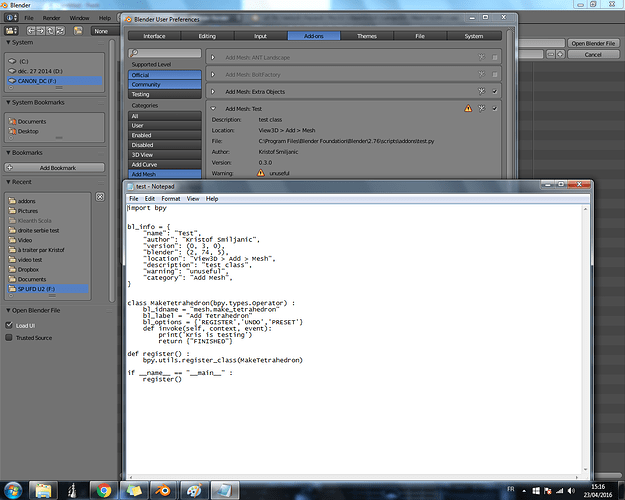I believe that you are getting “PASS_THROUGH” because you have no “execute()” function. Your script isn’t failing—it’s just not doing anything. “Pass through” simply means that the operator loaded correctly, and that there was noting more to do after that.
If it helps, here is a simple bit of code, that I downloaded from the Blender reference site. It is a good example of the use of the execute() function. It is also a good example of operator properties, where the user can enter values. The code is fully functional, and can be run from the text editor. Hopefully, you will find it as helpful as I did.
#----------------------------------------------------------
# File twisted.py
#----------------------------------------------------------
import bpy, math
def addTwistedCylinder(context, r, nseg, vstep, nplanes, twist):
verts = []
faces = []
w = 2*math.pi/nseg
a = 0
da = twist*math.pi/180
for j in range(nplanes+1):
z = j*vstep
a += da
for i in range(nseg):
verts.append((r*math.cos(w*i+a), r*math.sin(w*i+a), z))
if j > 0:
i0 = (j-1)*nseg
i1 = j*nseg
for i in range(1, nseg):
faces.append((i0+i-1, i0+i, i1+i, i1+i-1))
faces.append((i0+nseg-1, i0, i1, i1+nseg-1))
me = bpy.data.meshes.new("TwistedCylinder")
me.from_pydata(verts, [], faces)
ob = bpy.data.objects.new("TwistedCylinder", me)
context.scene.objects.link(ob)
context.scene.objects.active = ob
return ob
#
# User interface
#
from bpy.props import *
class MESH_OT_primitive_twisted_cylinder_add(bpy.types.Operator):
'''Add a twisted cylinder'''
bl_idname = "mesh.primitive_twisted_cylinder_add"
bl_label = "Add twisted cylinder"
bl_options = {'REGISTER', 'UNDO'}
radius = FloatProperty(name="Radius",
default=1.0, min=0.01, max=100.0)
nseg = IntProperty(name="Major Segments",
description="Number of segments for one layer",
default=12, min=3, max=256)
vstep = FloatProperty(name="Vertical step",
description="Distance between subsequent planes",
default=1.0, min=0.01, max=100.0)
nplanes = IntProperty(name="Planes",
description="Number of vertical planes",
default=4, min=2, max=256)
twist = FloatProperty(name="Twist angle",
description="Angle between subsequent planes (degrees)",
default=15, min=0, max=90)
location = FloatVectorProperty(name="Location")
rotation = FloatVectorProperty(name="Rotation")
# Note: rotation in radians!
def execute(self, context):
ob = addTwistedCylinder(context,
self.radius, self.nseg, self.vstep, self.nplanes, self.twist)
ob.location = self.location
ob.rotation_euler = self.rotation
#context.scene.objects.link(ob)
#context.scene.objects.active = ob
return {'FINISHED'}
#
# Registration
# Makes it possible to access the script from the Add > Mesh menu
#
def menu_func(self, context):
self.layout.operator("mesh.primitive_twisted_cylinder_add",
text="Twisted cylinder",
icon='MESH_TORUS')
def register():
bpy.utils.register_module(__name__)
bpy.types.INFO_MT_mesh_add.prepend(menu_func)
def unregister():
bpy.utils.unregister_module(__name__)
bpy.types.INFO_MT_mesh_add.remove(menu_func)
if __name__ == "__main__":
register()




